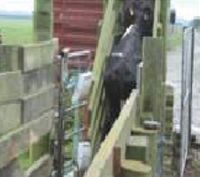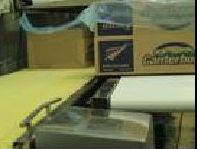GS1 New Zealand has just published a report on a study that demonstrates, the organization says, the efficacy of using the EPCglobal Network to track livestock from the farm to the retailer. The EPCglobal Network is a suite of Internet services for sharing product data around the world using a unique Electronic Product Code (EPC) encoded within RFID tags. The information, gathered at different RFID read points in the supply chain, could be used to help companies track and trace goods and product information. Consequently, companies might be better able to manage their supply chains more effectively, respond quickly to market needs, and meet safety and regulatory requirements from international export markets.
GS1 New Zealand, a member of the international organization that aims to make EPC technology the global RFID system for product identification, ran the trial in April 2010 with ANZCO Foods to track 10 cows from the feedlot to meat wholesaler. The report, entitled “The Efficacy of Using the EPCglobal Network for Livestock Traceability: A Proof of Concept,” is available for download from GS1 New Zealand’s Web site.
The project was a follow-up to two earlier New Zealand trials of UHF EPC Gen 2 technology for the tracking of animals run by the RFID Pathfinder Group and Rezare Systems. The Pathfinder Group determined that UHF tags were more efficient and more cost effective for tracking cattle and deer between the farm and a meat packing facility than traditional low-frequency (LF) tags during a trial in 2008 (see New Zealand Study Finds UHF Superior for Livestock Tracking). Software firm Rezare built on the Pathfinder Group’s findings during a trial in 2009 by using commercially available UHF tags and readers to track sheep and deer during standard animal-handling operations.
One of the report’s authors is Gary Hartley, who is GS1 New Zealand’s general manager, as well as the secretary of RFID Pathfinder Group. Hartley says Rezare secured funding to extend the trials of UHF EPC Gen 2 tags for livestock as it was transported from the farm to a meat processor.
“We were satisfied with the performance of UHF tags for tracking livestock in the previous two trials,” he says. “The technology was proven and further trials were pointless. Instead, we decided it was time to move on and test the EPCglobal Network as a tool for traceability. We have been hearing about the benefits of the EPCglobal Network for some years now but no one is using it. So we wanted to put the network to the test and demonstrate that it does work, and that it can provide a competitive advantage to businesses.”
Rezare opted to work in collaboration with GS1 New Zealand and ANZCO Foods to examine the efficacy of the EPCglobal Network in tracking livestock from the farm to the retailer.
RFID tags with unique EPC identifiers were attached to ears of 10 cows sourced from a farm in Ashburton, New Zealand, and the animals were then transferred to CMP Canterbury meat-processing plant, both of which are owned by ANZCO Foods. The ear tags were encoded with a Serialized Global Trade Item Number (SGTIN). After the cows were slaughtered, RFID tags were attached to the carcasses and encoded with a Serialized Shipping Container Code (SSCC). When the meat was processed, carton tags were attached to the finished product and encoded with a SGTIN. Each tag read location was also assigned a Serialized Global Location Number (SGLN).
The tags were read at total of nine separate stages in the supply chain. To fasten the tags to the animal’s ears on the farm, the group used a Tracient Padl UHF handheld reader. To document the animals’ departure from the farm on a truck, the group used an Intermec fixed reader. A Motorola XR-450 fixed reader was used to read the ear tags upon the animals’ arrival at the processor holding yards, and the ear tags were read for the last time, using a Convergence Systems Ltd. CS203 fixed reader, when the animals were placed in the stun box. From there, the carcass were fitted new RFID tags, which were read when the carcasses were stored in the chiller room and moved to the boning room, both times using a Motorola XR-450 fixed reader. The processed meat was packed into cartons fitted with RFID tags, which were read by the Motorola XR-450. When the cartons were loaded into a shipping container, the carton tags were read again. Finally, the cartons were received at Westmeat wholesalers, owned by ANZCO, and read using Tracient Padl UHF handheld readers.
The trial used Invengo UHF Gen 2 tags to track the cattle and carcasses, and Avery Dennison AD-843 Gen 2 UHF tags to track the cartons.
“We included a number of different tags and readers in the trial because it was important to show that with the standards in place, any off-the-shelf technology can be used,” says Hartley. “We are vendor agnostic and wanted to show that different tags and readers were interoperable.”
All tag data was successfully captured and recorded at each read point and transmitted in XML format using commercially available EPC middleware provided by Sedna Systems to GS1 Hong Kong‘s EPCIS server EzTrack, which collaborated with GS1 New Zealand. The tag data was not transmitted in real time, but was batch uploaded within a few hours of the read.
“We wanted to prove that the EPCglobal Network would provide traceability, and we did that; information was read, sent and interrogated in a standardized way and provided meaningful business information,” Hartley says. “The need for traceability of foods is gaining momentum, and we showed that EPCglobal Network can provide supply chain visibility, to allow for better supply chain management. There is a real opportunity here; the standards are in place, the technology is improving and it is time for companies to develop a business case and see if there is a competitive advantage in terms of real time visibility and traceability.”
ANZCO Foods sells its meat products in Europe, North American and Asia. The company’s IT manager, Mark Rance, agrees the time is coming when companies must examine the business benefits of RFID and the EPCglobal Network.
“We have been closely associated with GS1 New Zealand and the trials of UHF from the start because we feel this is something that will be expected of businesses in the future,” he says. “Traceability is being increasingly talked about, and it is just a matter of when technology like this will be needed. We got involved in these trials to make sure we stayed ahead of the curve.”
Rance says the trial has shown the potential benefits of UHF EPC RFID tags and the EPCglobal Network through increased supply chain visibility and traceability of livestock and processed meat. But he said further adoption by ANZCO Foods would be driven by customer demands, such as meat processors and retailers, for supply chain visibility.




